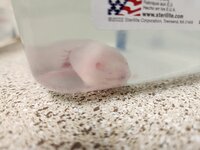Deetheking
New member
I'm having some problems with my two axe's over the course of the last week where there gills have deteriorated or completely disappeared. Along with one them (albino) showing yellowish sores on their tail. I've done some research and have been giving them regular salt baths along with replacing their water every day. If anyone else has any suggestions please do comment.
Thanks in advance for you help
Thanks in advance for you help












